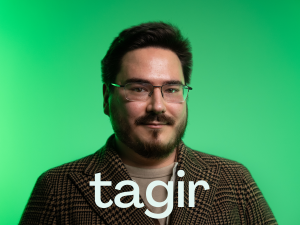‟ Big breakthroughs don’t come from one person sitting all alone. They happen best when researchers from diverse academic backgrounds collaborate.”
Meet Tagir Fabarisov, our newest researcher. Tagir brings a unique perspective – he specialises in identifying where complex systems are likely to fail. He uses AI to explore how to improve the weak points in systems to make them safer, more efficient, and reliable. Influenced by his father’s engineering path and inspired by Alan Turing’s ability to turn abstract mathematics into working machines, Tagir joined SnT in 2025.
Relive the conversation—transcript below!
What is your background and what brought you to Luxembourg?
I’m from Ufa, the capital of the Bashkortostan Republic in Russia. I completed my bachelor’s and master’s degrees in mathematical modelling and computational analysis at Ufa State Aviation Technical University. A year on exchange in Germany as part of my studies steered my research towards AI and formal verification.
What are you focussing on in your postdoctoral research?
I work on using AI to verify the design of complex technological systems. Think of it like using Lego blocks to build structures – there are endless combinations. I use AI to find the safest, most efficient design for complex systems like satellites or smart infrastructure, where hardware and software are closely integrated.
Could you explain your approach a bit further?
Usually engineers focus on how to build robust and dependable systems. But my starting point is to look for the ways systems might fail. By finding weaknesses before a system is deployed, and exploring better design variants, I make the systems more reliable and trustworthy.
How did your journey in tech research begin?
It began with my father, who joined a “Soviet era” tech club in the 1970s. Years later, he brought me along – by then the club had evolved from soldering circuits to programming. Participating in that club sparked my engineering mindset.
Who’s your role model in the field of technology or research?
I admire Alan Turing’s mind. When he was in his late twenties, he worked without computers – just with basic electronics and relays. In the end, he bridged mathematical concepts with the physical world to build the first computers. His ability to create something so foundational from pure theory is something I believe every engineer should learn from.
What do you think is the biggest misconception about AI?
I laugh when people ask if AI is just a computer brain that thinks like humans. That’s not how it works. Imagine thousands of mathematicians solving equations on an infinite sheet of paper. They’d get the same results as an AI, but the paper itself isn’t intelligent, and neither is the AI. It’s more like a very advanced calculator. But it doesn’t “think” in the human sense.
What advice do you give students who feel they don’t “fit the mould” for tech research?
I ask them, “What mould?”. In research, there shouldn’t be one. You need to challenge everything and think outside the box. Having a mindset that breaks things down to understand and rebuild them is all you need as a starting point to become a researcher. Everything else can be learned.
What is the most underrated skill in tech research?
Communication. Many researchers have brilliant ideas but struggle to communicate effectively. They might be shy or lack presentation skills. But having strong results isn’t enough.
‟ You need to be able to communicate them – to industry partners, academic peers, or students.”
What common stereotypes about scientists make you laugh?
As a child, I imagined scientists in white lab coats conducting experiments. But actually, we’re mostly staring at computer screens, debugging software, and drinking excessive amounts of coffee.
‟ we’re mostly staring at computer screens, debugging software, and drinking excessive amounts of coffee.”
How do you think tech research needs to evolve?
Tech research needs people from different fields. The biggest breakthroughs don’t come from one person sitting by a computer all alone. They happen when researchers from diverse academic backgrounds collaborate.
Supported by the Luxembourg National Research Fund
